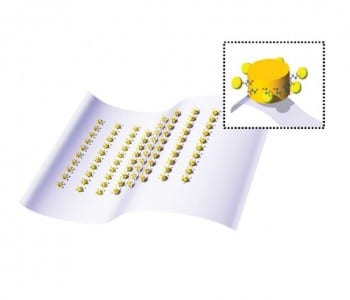 Low concentrations (10 × 10−15 mol L–1) of the disease biomarker microRNA-21 (miRNA-21) can be detected by a flexible biosensor. The biosensor, which was developed by Jihye Lee and co-workers, consists of an array of functionalized gold nanostructures on a flexible poly(ethylene terephthalate) substrate. The functionalization provides a tool to catch miRNA-21 biomarker molecules in biosamples, which are then labeled by modified gold nanoparticles (GNPs). Through this heteroaggregation a detectable change in the scattering wavelength of the array is induced.
Low concentrations (10 × 10−15 mol L–1) of the disease biomarker microRNA-21 (miRNA-21) can be detected by a flexible biosensor. The biosensor, which was developed by Jihye Lee and co-workers, consists of an array of functionalized gold nanostructures on a flexible poly(ethylene terephthalate) substrate. The functionalization provides a tool to catch miRNA-21 biomarker molecules in biosamples, which are then labeled by modified gold nanoparticles (GNPs). Through this heteroaggregation a detectable change in the scattering wavelength of the array is induced.
The biosensor is selective for miRNA-21 because of unique interactions between several RNA probes. The gold nanostructures are functionalized with an RNA probe on their side edges. In biosamples, several microRNAs, including miRNA-21, can bind to this probe. Afterwards, the immobilizedmiRNA-21 molecules are selectively recognized by GNPs via a second RNA probe. Detection of the miRNA-21–GNP occurs because of plasmon resonance effects. The plasmon resonance of the array, and therefore its scattering wavelength, changes upon the interaction with gold nanoparticles. Since this is only possible in the presence of miRNA-21, the detection of a change in the scattering wavelength is a selective indicator for the biomarker.
 With a sensitivity of 10 × 10−15 mol L–1 this approach is highly suitable for clinical applications, since they require a selectivity of only 10 × 10−12 mol L–1. Further enhancement of the sensitivity could be realized by optimizing the geometry of the array. Therefore, the method is likely to be also adapted to further applications, such as strain gauge sensors, functional molecular devices, or the detection of different biomolecules.
With a sensitivity of 10 × 10−15 mol L–1 this approach is highly suitable for clinical applications, since they require a selectivity of only 10 × 10−12 mol L–1. Further enhancement of the sensitivity could be realized by optimizing the geometry of the array. Therefore, the method is likely to be also adapted to further applications, such as strain gauge sensors, functional molecular devices, or the detection of different biomolecules.
Advanced Science is a new journal from the team behind Advanced Materials, Advanced Functional Materials, and Small. The journal is fully Open Access and is free to read now at www.advancedscience.com.

















